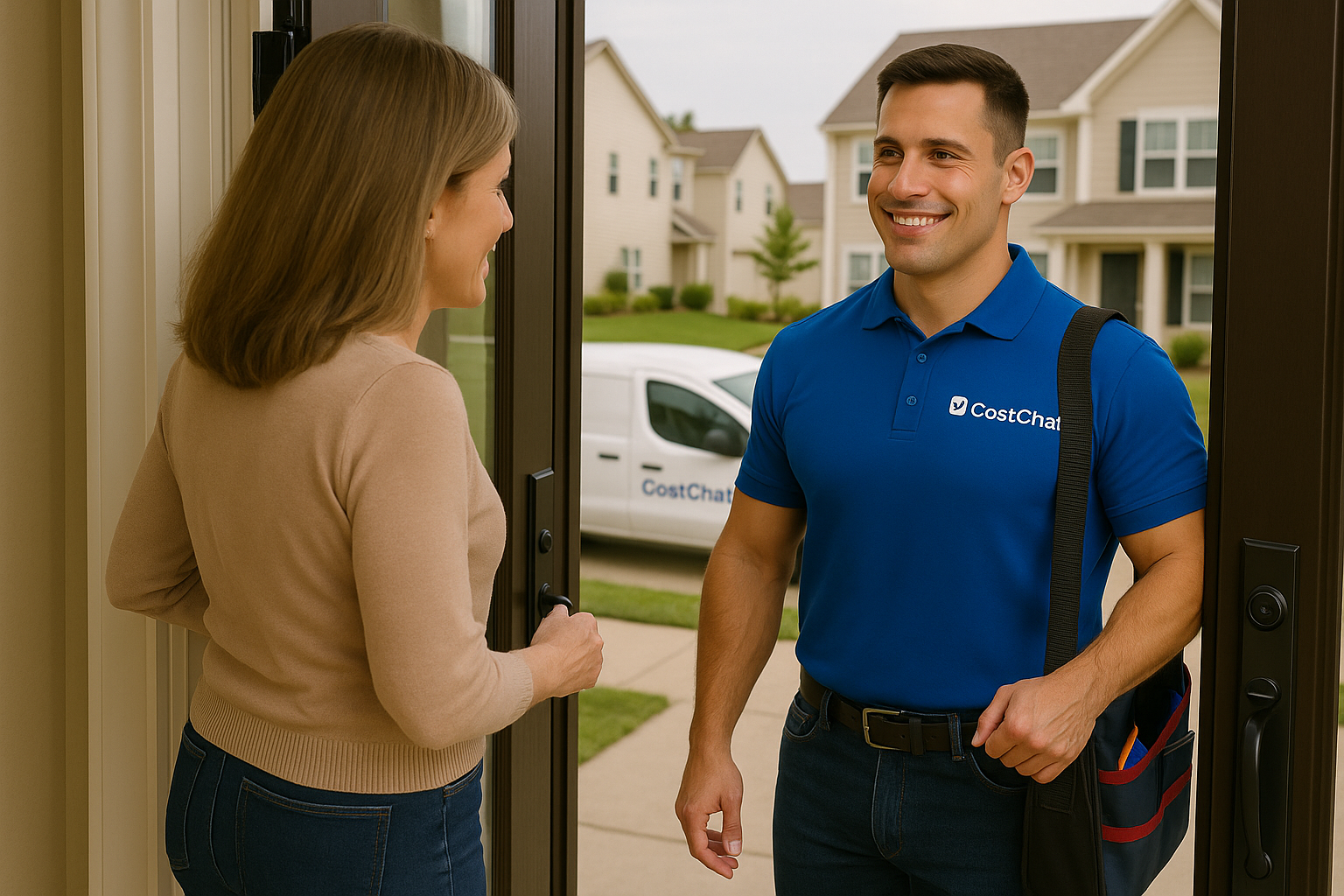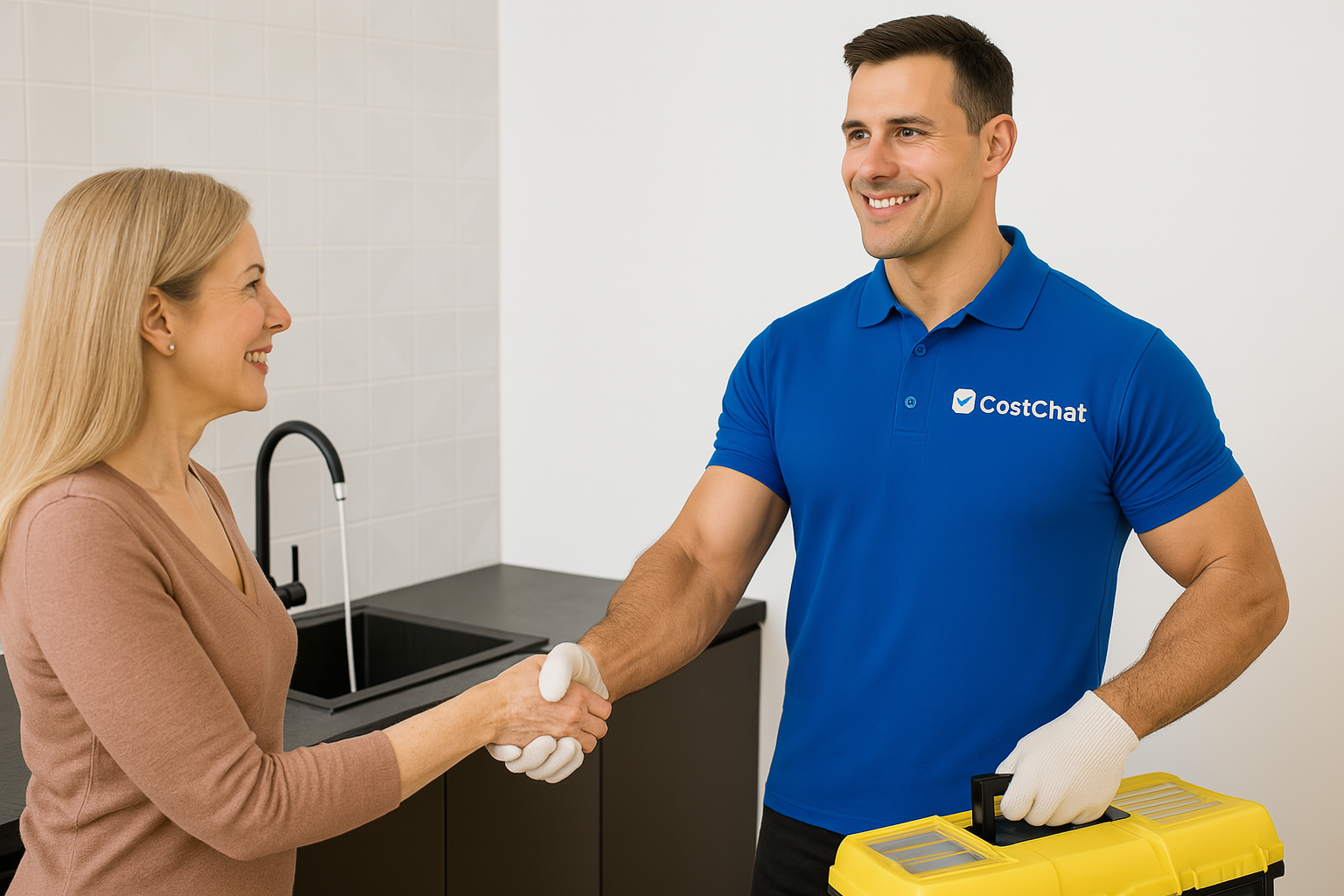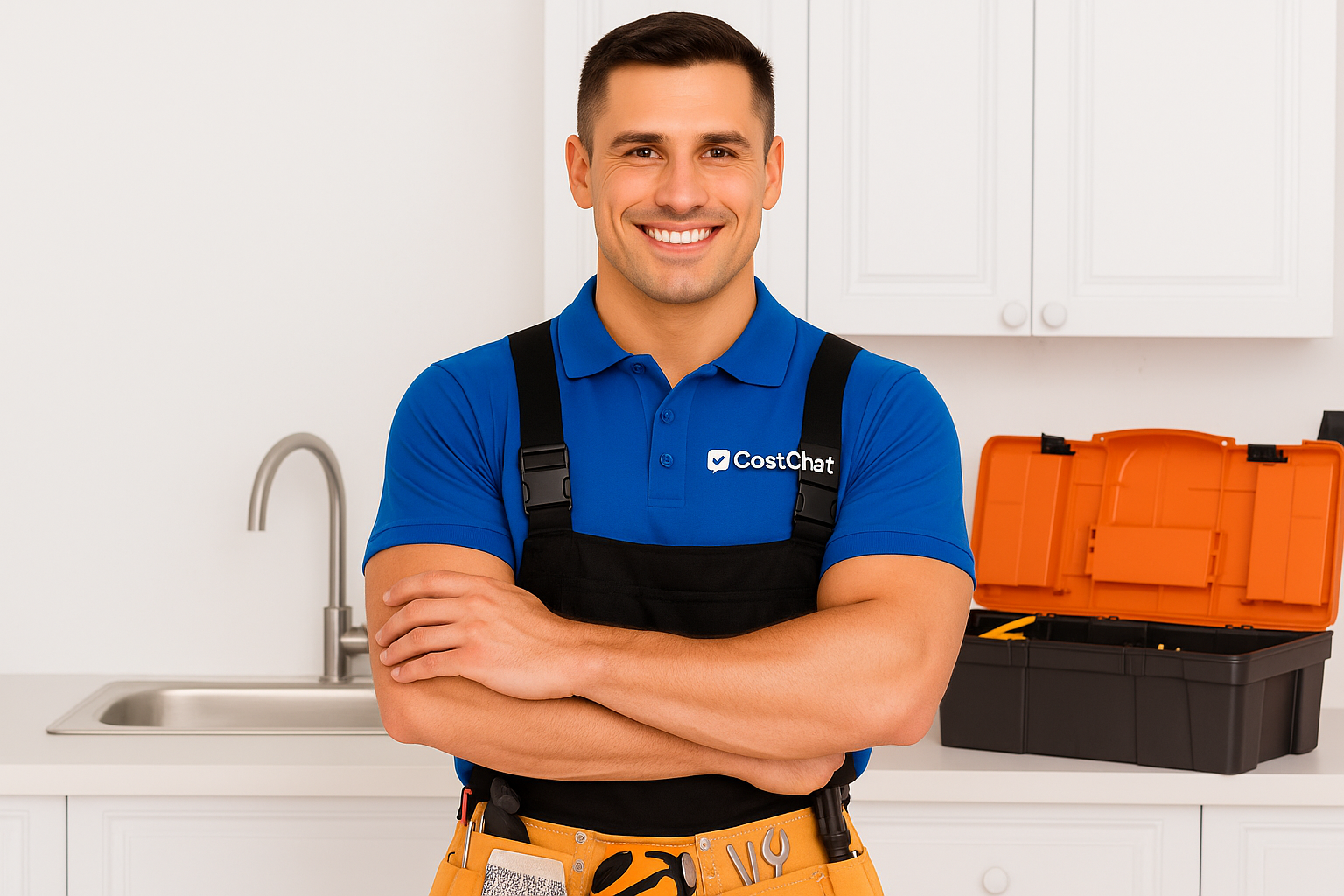
Hire Top Leak Detection and Repair Pros Today in Cincinnati, OH
How to Hire Top Rated Leak Detection and Repair Pros in Cincinnati, OH
Get a Free Online Estimate
Share your project details and receive a free online estimate from top-rated local pros. Not sure what it should cost? Check our Cost Guide.
Get EstimateCompare Local Quotes
View multiple free online quotes side by side. Use our Price Guide to understand labor rates, materials, and service fees before you hire.
Compare NowBook Best Top Rated Pros
Choose a licensed pro with confidence. Lock in your date after reviewing your free estimate and browsing our expert Cost Guide for peace of mind.
Book NowDid You Know?
74% ⚠️
of homeowners face surprise costs and delays — mostly from hiring unvetted pros. Don’t risk it. Hire trusted experts today.
Hire Top Rated & Verified ProsWork With Verified & Trusted Pros 🛡️
Save time, avoid costly mistakes, and experience reliable, top-quality service for every home project. Book now for priority scheduling and peace of mind.
Hire a Top Rated ProGet Instant Online Estimate of Leak Detection and Repair in
🔎 CostChat Online Cost Estimator
Describe your project and location to get an instant estimate.
Cincinnati Leak Detection and Repair: Your Comprehensive Homeowner's Guide
As a homeowner in Cincinnati, OH, you understand the unique charm and character of our city's homes. You also know that maintaining that charm, especially with the specific environmental factors and housing stock we have, can come with its own set of challenges. Leaks, whether hidden or apparent, can silently undermine your home's integrity, leading to costly damage and unhealthy living conditions. This guide is designed to equip you with the local knowledge you need to understand, prevent, and address leak detection and repair issues specific to Cincinnati, Ohio, ensuring your home remains a comfortable and secure sanctuary.
Table of Contents
- Cincinnati, OH's Unique Leak Detection and Repair Landscape: Why Local Expertise Matters
- Neighborhood Hotspots: Micro-Local Leak Detection and Repair Risks & Solutions
- Common Problems & Triggers for a Professional Leak Detection and Repair Call
- Navigating Cincinnati, OH's Regulations: Permits, Code & Professional Licensing
- Maximize Your Savings: Cincinnati, OH Leak Detection and Repair Rebates & Incentives
- Choosing Your Cincinnati, OH Leak Detection and Repair Component: Models, Sizing & Smart Features
- The Cost of Leak Detection and Repair in Cincinnati, OH
- Hiring Cincinnati, OH's Top-Rated Leak Detection and Repair Professional: Your Action Plan
- FAQs About Leak Detection and Repair in Cincinnati, OH
Cincinnati, OH's Unique Leak Detection and Repair Landscape: Why Local Expertise Matters
The Age & Character of Cincinnati, OH Homes: A Leak Detection and Repair-Related Time Capsule
Cincinnati's housing stock is a rich tapestry, reflecting its long history. With a population of approximately 312,000 residents within 79 square miles, many homes, particularly in established neighborhoods, are showing their age. This history directly impacts plumbing systems, making them more susceptible to leaks. Understanding the age of your home and its common architectural styles is crucial for anticipating potential leak detection and repair needs.
- Early to Mid-20th Century Homes (1920s-1960s): These homes, prevalent in neighborhoods like Hyde Park, Oakley, and parts of Mount Adams, often feature beautiful Craftsman bungalows, Colonial Revivals, and post-war suburban designs. The plumbing in these homes frequently utilizes materials like galvanized steel pipes and cast iron drains. Galvanized pipes are prone to internal corrosion and mineral buildup, significantly reducing water pressure and increasing the risk of leaks. Cast iron drains, while durable, can degrade over time, leading to blockages and leaks, especially at joint connections.
- Older Brick and Wood-Framed Homes: Many Cincinnati residences, especially those built before the 1950s, are constructed with these traditional materials. While aesthetically pleasing, these older structures can have plumbing systems that require thorough inspection and potential updates due to age and wear. Remodeling projects in these homes can often uncover or exacerbate existing vulnerabilities in the plumbing.
Leak Detection and Repair's Environmental & Utility Factors & Climate Impact on Your Plumbing
Cincinnati's specific climate and its reliance on local water sources create unique challenges for home plumbing systems, directly affecting the need for leak detection and repair.
- Water Source and Quality: Greater Cincinnati Water Works (GCWW) supplies water sourced from the Ohio River and the Great Miami Buried Valley Aquifer. While GCWW employs rigorous multi-stage filtration and treatment processes, including UV light and corrosion control, to ensure safe tap water, the water is classified as moderately hard. This moderate hardness can contribute to mineral scale buildup in plumbing fixtures and pipes over time. Consistent scale buildup can narrow pipe diameters, increase water pressure within the system, and potentially lead to pinhole leaks or premature pipe failure. Regular inspections and considering water softening solutions can mitigate these effects.
- Cincinnati's Climate: Cincinnati experiences a humid continental climate with cold winters and warm, wet summers.
- Winter Freeze-Thaw Cycles: These cycles can cause pipes to freeze and potentially burst if not adequately insulated, especially those located in unheated areas like crawl spaces or exterior walls.
- Seasonal Rainfall and Soil Conditions: The region's variable rainfall saturates soils, which can lead to ground movement. Cincinnati's soil composition, often clay-heavy in many neighborhoods, is prone to expansion and contraction with moisture changes. This can stress underground plumbing lines, increasing the likelihood of leaks or breaks.
- Flooding Risks: Proximity to the Ohio River means some areas face increased flood risks, which can impact basement plumbing. Proper sump pump operation and backflow preventers are essential for homes in flood-prone zones.
 Request a Quote
Request a QuoteNeighborhood Hotspots: Micro-Local Leak Detection and Repair Risks & Solutions
Cincinnati's diverse neighborhoods present unique challenges for leak detection and repair, often tied to their specific development eras and local topography.
- Hyde Park & Oakley: These historic neighborhoods feature many homes from the early to mid-20th century. Residents here often deal with issues stemming from aging galvanized steel pipes and cast iron drain lines. Solution: Prioritize plumbing inspections during home renovations. Consider PEX or copper repiping for sections prone to corrosion or leaks.
- Mount Adams: Known for its older, sometimes steeply sloped properties, Mount Adams homes can experience plumbing stress due to terrain and foundational movement. Solution: Regular inspection of exposed pipes in basements and crawl spaces is key. Ensure proper drainage around the foundation to minimize soil pressure.
- Areas with Clay Soil (common in many Cincinnati neighborhoods): The expansive nature of clay soil can put significant pressure on underground water and sewer lines. Solution: Be vigilant for signs of underground leaks like unexplained wet spots in the yard or foundation cracks. Consider professional leak detection services that specialize in underground lines.
- Homes with Slab Foundations: Especially in areas with shifting soil, slab leaks are a concern. Solution: Look for hot spots on floors or unusual sounds of running water. Electronic leak detection is often required to pinpoint the exact location.
Common Problems & Triggers for a Professional Leak Detection and Repair Call
Recognizing the signs of a leak early can save you significant money and prevent further damage. In Cincinnati, several common indicators point to a potential problem with your plumbing system.
- Reduced Water Pressure: This is often caused by mineral buildup in older galvanized pipes or pinhole leaks developing within the system. For pipes installed before the 1970s, this is a particularly common issue.
- Unexplained Water Stains or Mold Growth: These are classic signs of hidden moisture, often originating from slow leaks behind walls, under floors, or in ceilings.
- The Sound of Running Water: If you hear water running when no fixtures are in use, it's a strong indicator of a leak, possibly in an underground line or a continuously running toilet.
- High Water Bills: A sudden or gradual increase in your water bill, without a corresponding increase in usage, is a significant warning sign.
- Cracked or Damaged Foundations: In homes with slab foundations, this can indicate a slab leak that is eroding the soil beneath your home.
- Musty Odors: Persistent musty smells, especially in basements or crawl spaces, can signal hidden water intrusion or mold growth due to a leak.
For more detailed information on identifying potential issues, consult our guide on Warning Signs of Plumbing Problems.
 Request a Quote
Request a QuoteNavigating Cincinnati, OH's Regulations: Permits, Code & Professional Licensing
Ensuring your leak detection and repair work complies with local regulations is vital for safety and legality. Cincinnati enforces specific codes and permit requirements.
- Permitting Authority: Plumbing permits in Cincinnati are managed by the Cincinnati Building and Inspections Department. Significant plumbing work, including repiping, fixture installation, or water heater replacement, requires a permit. You can find more information on their website: Cincinnati Building and Inspections Department.
- Governing Code: Cincinnati adheres to the Ohio Plumbing Code, which is largely based on the International Plumbing Code (IPC) but includes local amendments tailored to regional conditions. These amendments may cover aspects like frost protection for pipes.
- Required Inspections: Typically, inspections are required at various stages of plumbing work, often including:
- Rough-in inspection (before walls are closed up)
- Final inspection (upon completion of work)
- DIY vs. Professional: While some minor plumbing tasks might be suitable for DIY enthusiasts, major leak detection and repair, especially involving pipe replacement or underground lines, is highly recommended to be performed by a licensed professional. This ensures work meets code, is performed safely, and is backed by expertise. For guidance on what you can tackle yourself, see our When To Consider DIY guide.
- Contractor Licensing: All plumbers working in Ohio must be licensed by the Ohio Construction Industry Licensing Board (OCILB). You can verify a plumber's license through the Ohio Department of Commerce. Always ask to see credentials and verify them independently.
Maximize Your Savings: Cincinnati, OH Leak Detection and Repair Rebates & Incentives
Investing in leak detection and repair services or upgrades can be offset by available rebates and incentives, helping Cincinnati homeowners save money and improve efficiency.
- Water Conservation Rebates: Greater Cincinnati Water Works (GCWW) and state initiatives often offer rebates for water-saving fixtures and plumbing upgrades. These can include:
- High-efficiency toilets
- Low-flow showerheads and faucets
- Water heater upgrades
- Energy Efficiency Programs: While not always directly for leak detection, improving your plumbing can be part of a larger energy efficiency upgrade. Keep an eye on programs from utility companies or state energy offices.
- Bonus Tip: The best time to look for rebates is often when you're already planning a renovation or upgrade, as many incentives require specific types of installations. Check for any updated programs before starting your project.
For the most current information on available programs, visit the Greater Cincinnati Water Works website and the Ohio EPA's water conservation pages.
For tips on managing costs and finding value, explore our Saving Tips guide.
 Request a Quote
Request a QuoteChoosing Your Cincinnati, OH Leak Detection and Repair Component: Models, Sizing & Smart Features
When addressing leaks or upgrading your plumbing, selecting the right components and understanding sizing is crucial for long-term performance and efficiency in Cincinnati's climate.
- Pipe Materials:
- PEX Tubing: Increasingly popular for its flexibility, ease of installation, and resistance to freezing and bursting compared to copper. It's a great option for replacing aging galvanized pipes.
- Copper: A reliable and durable option, but can be more expensive and susceptible to corrosion in certain water conditions if not properly maintained.
- PVC/ABS: Primarily used for drain, waste, and vent (DWV) systems. Ensure proper venting to prevent sewer gases and maintain consistent drainage.
- Sizing and Application: Proper sizing ensures adequate water flow and pressure throughout your home, regardless of neighborhood or house size. A professional assessment is recommended to determine the correct pipe diameters and fixture unit calculations based on your home's demand.
- Key Considerations for Cincinnati Homes:
- Freeze Protection: Ensure any exposed pipes in crawl spaces or unfinished basements are properly insulated to prevent freezing during Cincinnati winters.
- Water Quality: Given the moderate hardness of Cincinnati water, consider the long-term effects of scale buildup on different pipe materials and fixtures.
- Underground Lines: For homes with older underground service lines or those in areas with known soil movement, durable materials and professional installation are paramount.
The Cost of Leak Detection and Repair in Cincinnati, OH
The cost of leak detection and repair services in Cincinnati, OH can vary significantly based on the complexity of the issue, the materials used, and the location within the city. Homeowners can expect the following cost considerations:
- Leak Detection Services:
- Surface Leaks: Detecting visible leaks is usually included in a standard service call fee.
- Underground or Hidden Leaks: Specialized electronic leak detection can range from $200 - $500+, depending on the extent of the search required.
- Pipe Repair/Replacement:
- Minor Pipe Repair: A simple repair to a single pipe section might cost between $150 - $400.
- Repiping (Partial or Full): Replacing sections of galvanized or old copper piping can range from $1,500 - $6,000+, depending on the size of the home and the extent of the repiping. This is common in homes built before the 1970s.
- Slab Leak Repair: These are typically more expensive due to the difficulty in accessing the leak, often costing between $500 - $2,500+.
- Factors Influencing Cost:
- Accessibility: Leaks within walls, under slabs, or in hard-to-reach areas will incur higher labor costs.
- Materials: The cost of PEX, copper, or other plumbing materials impacts the overall price.
- Neighborhood: While labor rates are generally standard, some older neighborhoods might present unique challenges affecting time on site.
- Emergency Service: After-hours or weekend calls often incur higher rates.
As a general guideline, the average homeowner in Cincinnati might spend anywhere from a few hundred dollars for a minor repair to several thousand dollars for major repiping or extensive leak remediation. It's always advisable to get multiple itemized quotes from licensed professionals.
 Request a Quote
Request a QuoteHiring Cincinnati, OH's Top-Rated Leak Detection and Repair Professional: Your Action Plan
Choosing the right professional for your leak detection and repair needs in Cincinnati is crucial. Here’s a step-by-step action plan:
- Verify Licensing and Insurance: Always confirm that your chosen professional is licensed by the Ohio Construction Industry Licensing Board (OCILB) and carries adequate liability insurance. This protects you from potential damages and ensures they are qualified.
- Ask Hyper-Local Questions: Tailor your questions to Cincinnati's specific issues:
- "How do you handle repairs for homes with older galvanized steel pipes common in neighborhoods like Hyde Park?"
- "What methods do you use for leak detection in homes with clay soil foundations prevalent in the Cincinnati area?"
- "Are you familiar with the specific requirements of the Ohio Plumbing Code as it applies to our area?"
- Check Local Reviews and References: Look for reviews on reputable platforms that specifically mention their experience in Cincinnati. Ask for references from recent clients, preferably in your neighborhood.
- Obtain Multiple Detailed Quotes: Get at least three written estimates. Ensure they are detailed, outlining the scope of work, materials to be used, labor costs, and any potential additional charges.
- Review the Contract Carefully: Before any work begins, ensure you have a written contract that includes all agreed-upon terms, pricing, warranty information, and a clear timeline for completion.
Avoid common pitfalls by consulting our guide on Mistakes to Avoid When Hiring a Contractor.
Neighborhoods We Serve in Cincinnati, OH
️ Top Neighborhoods:
- Downtown
- Over-the-Rhine
- Mount Adams
- Clifton
- Corryville
- Hyde Park
- Walnut Hills
- East Walnut Hills
- Mount Lookout
- Mount Washington
- Avondale
- Northside
- College Hill
- Pendleton
- West End
Top ZIP Codes Covered:
- 45202
- 45203
- 45204
- 45205
- 45206
- 45207
- 45208
- 45209
- 45211
- 45212
- 45213
- 45214
- 45216
- 45219
- 45220
Wherever you’re located in Cincinnati, OH, our team of trusted local pros is nearby—ready to deliver fast, reliable, and top-rated service. Whether you’re in the heart of downtown or a quiet suburb, we’ve got you covered.
FAQs About Leak Detection and Repair in Cincinnati, OH
What are the most common signs of a hidden leak in a Cincinnati home, especially in older properties?
In Cincinnati, especially with homes built before the 1970s, common signs of hidden leaks include unexplained damp spots on walls or ceilings, peeling paint or wallpaper, musty odors, or a persistent increase in your water bill. You might also notice warping floorboards or foundation cracks, which could indicate a slab leak common in areas with clay-heavy soils that expand and contract.
How does Cincinnati's climate, particularly the freeze-thaw cycles, impact the risk of pipe leaks?
Cincinnati's winter freeze-thaw cycles can cause pipes to expand and contract. If pipes are not properly insulated, especially those in unheated areas like crawl spaces or exterior walls, they can freeze, crack, or even burst. This can lead to significant water damage and costly repairs. Ensuring adequate insulation is key to preventing these issues.
Should I be concerned about the water quality from Greater Cincinnati Water Works (GCWW) regarding my plumbing lifespan?
GCWW provides safe, treated water. However, the water is classified as moderately hard, which can lead to mineral scale buildup over time. This buildup can narrow pipes, reduce water pressure, and potentially cause stress or leaks in older plumbing systems. Regular inspections and considering water softening can help mitigate these long-term effects.
What permits are typically required for leak detection and repair work in Cincinnati, OH?
Permits are generally required by the Cincinnati Building and Inspections Department for significant plumbing work, such as repiping, adding new fixtures, or replacing water heaters. Minor repairs may not always require a permit, but it's best to check with the department or your licensed plumber to ensure compliance with local codes and safety standards.
Addressing leaks promptly and effectively is essential for m
